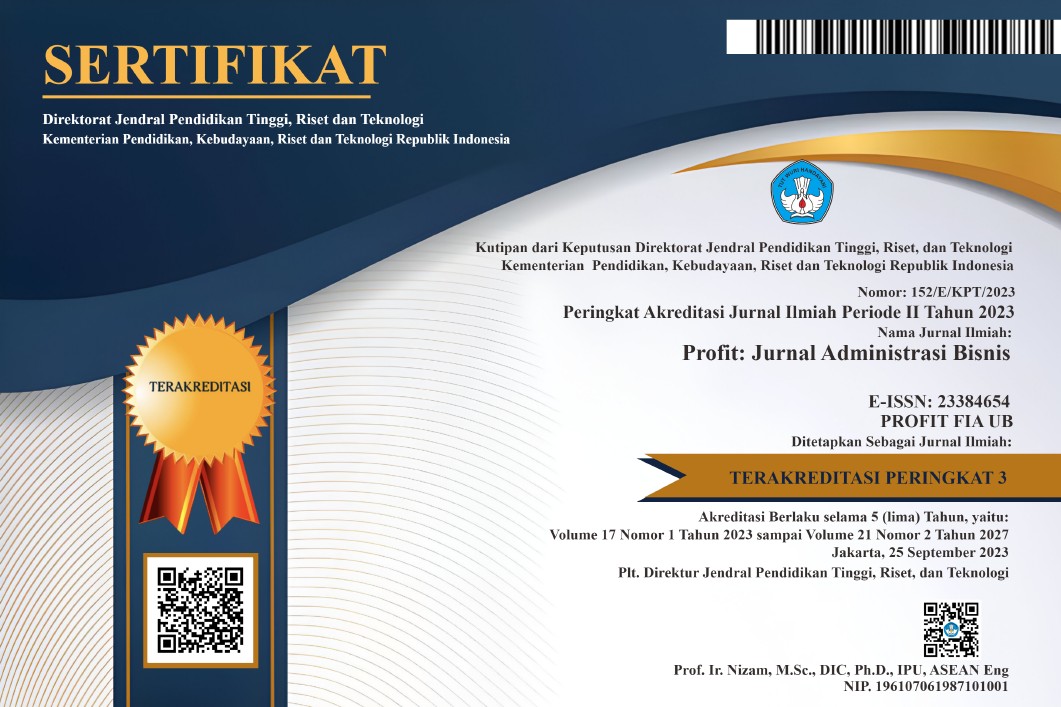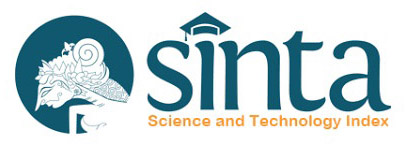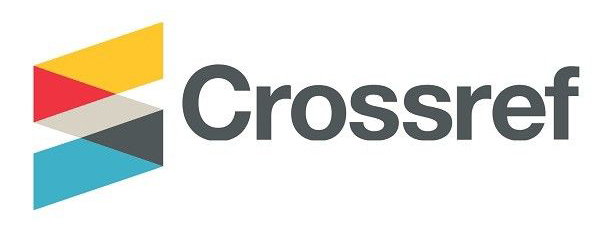Analysis of The Relationship of Information Technology Capability to Innovation and Organizational Performance ( Meta-Analysis)
DOI:
https://doi.org/10.21776/ub.profit.2023.017.01.6Keywords:
IT capability; innovation; organizational performance; meta-analysisAbstract
This study aims to analyze the influence of information technology (IT) capabilities on innovation and organizational performance. This study uses a meta-analysis method with JASP software. The articles that will be used as research objects are search results in online databases such as sciencedirect, emerald insight, EBSCO, wiley, ProQuest and Springer where these articles are published in Scopus indexed international journals with the keywords Information Technology Capability/IT Capability – Innovation – Organizational Performance/Business Performance. From the search, 1,171 articles were found, then a systematic selection was carried out to produce 12 articles to be analyzed. The results of statistical analysis show that IT capability has a significant positive effect on innovation, IT capability has a significant positive effect on organizational performance and innovation has a significant positive effect on organizational performance. The results of this research are practically expected to be able to provide recommendations to business people, especially regarding IT capabilities and innovation in improving organizational performance; and theoretically can support or block the results of previous studies related to information technology capabilities, innovation or organizational performance.
References
Alaarj, S., Abidin-Mohamed, Z., & Bustamam, U. S. B. A. (2016). Mediating Role of Trust on the Effects of Knowledge Management Capabilities on Organizational Performance. Procedia - Social and Behavioral Sciences, 235, 729–738. https://doi.org/10.1016/j.sbspro.2016.11.074
Amrul, S., & Hardi, E. (2010). Pengaruh Organizational Learning dan IT Capability terhadap Financial Performance. Jurnal Akuntansi Dan Auditing Indonesia, 14(1), 87–99.
Ausat, A. M. A., & Suherlan, S. (2021). Obstacles and Solutions of MSMEs in Electronic Commerce during Covid-19 Pandemic: Evidence from Indonesia. BASKARA : Journal of Business and Entrepreneurship, 4(1), 11. https://doi.org/10.54268/baskara.4.1.11-19
Balkin, D. B., Markman, G., & Gomez-Mejia, L. R. (2000). Is CEO Pay in High-Technology Firms Related to Innovation? The Academy of Management Journal, 43(6), 1118–1129.
Barba-Sánchez, V., Calderón-Milán, M. J., & Atienza-Sahuquillo, C. (2018). A Study of The Value of ICT in Improving Corporate Performance: A Corporate Competitiveness View. Technological and Economic Development of Economy, 24(4), 1388–1407. https://doi.org/10.3846/tede.2018.3114
Barney, J. (1991). Firm Resources and Sustained Competitive Advantage. Journal of Management, 17(1), 99–120. https://doi.org/10.1177/014920639101700108
Bharadwaj, A. S. (2000). A Resource-Based Perspective on Information Technology Capability and Firm Performance: An Empirical Investigation. MIS Quarterly, 24(1), 169–196.
Carbonara, N. (2005). Information and communication technology and geographical clusters: Opportunities and spread. Technovation, 25(3), 213–222. https://doi.org/10.1016/S0166-4972(03)00095-6
Chae, H. C., Koh, C. E., & Prybutok, V. R. (2014). Information technology capability and firm performance: Contradictory findings and their possible causes. MIS Quarterly: Management Information Systems, 38(1), 305–326. https://doi.org/10.25300/MISQ/2014/38.1.14
Chapman, R. L., Soosay, C., & Kandampully, J. (2002). Innovation in logistic services and the new business model: a conceptual framework. In Managing Service Quality: An International Journal (Vol. 12, Issue 6, pp. 358–371). https://doi.org/10.1108/09604520210451849
Chen, J. S., & Tsou, H. T. (2012). Performance effects of IT capability, service process innovation, and the mediating role of customer service. Journal of Engineering and Technology Management - JET-M, 29(1), 71–94. https://doi.org/10.1016/j.jengtecman.2011.09.007
Chiu, C.-N., & Chen, H.-H. (2016). The Study of Knowledge Management Capability and Organizational Effectiveness in Taiwanese Public Utility: The Mediator Role of Organizational Commitment. Springer Plus, 5(1), 1–34. https://doi.org/10.1186/s40064-016-3173-6
Cho, H. J., & Pucik, V. (2005). Relationship between innovativeness, quality, growth, profitability, and market value. Strategic Management Journal, 26(6), 555–575. https://doi.org/10.1002/smj.461
Cuevas-Vargas, H., Estrada, S., & Larios-Gómez, E. (2016). The Effects of ICTs As Innovation Facilitators for a Greater Business Performance. Evidence from Mexico. Procedia Computer Science, 91, 47–56. https://doi.org/10.1016/j.procs.2016.07.040
Delgado-Rodríguez, M., & Sillero-Arenas, M. (2018). Systematic review and meta-analysis. Medicina Intensiva, 42(7), 444–453. https://doi.org/10.1016/j.medin.2017.10.003
Dibrell, C., Davis, P. S., & Craig, J. (2008). Fueling innovation through information technology in SMEs. Journal of Small Business Management, 46(2), 203–218. https://doi.org/10.1111/j.1540-627X.2008.00240.x
Dong, J. Q., & Yang, C. H. (2019). Information technology and innovation outcomes: is knowledge recombination the missing link? European Journal of Information Systems, 28(6), 612–626. https://doi.org/10.1080/0960085X.2019.1627489
Durán-Vázquez, R., Lorenzo-Valdés, A., & Moreno-Quezada, G. E. (2012). Innovation and CSR Impact on Financial Performance of Selected Companies in Mexico. Management and Innovation (JEMI), 8(3).
Easterby-Smith, M. (1997). Disciplines of Organizational Learning: Contributions and Critiques. Human Relations, 50(9), 1085–1113.
Garrido, M. J., & Camarero, C. (2009). Assessing the impact of organizational learning and innovation on performance in cultural organizations. International Journal of Nonprofit and Voluntary Sector Marketing, n/a-n/a. https://doi.org/10.1002/nvsm.384
Gopalakrishnan, S., & Damanpour, F. (2001). The Dynamics of the Adoption of Product and Process Innovations in Organizations. Journal of Management Studies, 38(1), 0022–2380.
Grant, R. M. (1996). Toward a knowledge-based theory of the firm. Strategic Management Journal, 17(SUPPL. WINTER), 109–122. https://doi.org/10.1002/smj.4250171110
Grant, R. M. (2015). Contemporary Strategy Analysis: Text and Cases Edition, 9th Edition. Wiley.
Gunday, G., Ulusoy, G., Kilic, K., & Alpkan, L. (2011). Effects of innovation types on firm performance. International Journal of Production Economics, 133(2), 662–676. https://doi.org/10.1016/j.ijpe.2011.05.014
Henderson, R. M., Kim, ;, & Clark, B. (1990). Architectural Innovation: The Reconfiguration of Existing Product Technologies and the Failure of Established Firms. In Administrative Science Quarterly (Vol. 35, Issue 1). http://www.jstor.org/about/terms.html.
Hermawan, I., Suharnomo, S., & Perdhana, M. S. (2021). Inimitable-based innovative entrepreneurship as mediation concepts of information technology roles on organizational performance. Business: Theory and Practice, 22(2), 380–391. https://doi.org/10.3846/btp.2021.13036
Holland, C., Lockett, G., & Blackman, I. (1992). Planning For Electronic Data Interchange. Strategic Management Journal, 13, 539–550.
Hoskisson, R. E., Hitt, M. A., Wan, W. P., & Yiu, D. (1999). Theory and Research in Strategic Management: Swings of a Pendulum. In Journal of Management (Vol. 25, Issue 3). https://doi.org/10.1177/014920639902500307
Hult, G. T. M., Hurley, R. F., & Knight, G. A. (2004). Innovativeness: Its antecedents and impact on business performance. Industrial Marketing Management, 33(5), 429–438. https://doi.org/10.1016/j.indmarman.2003.08.015
Kim, G., Shin, B., Kim, K. K., & Lee, H. G. (2011). IT Capabilities, Process-Oriented Dynamic Capabilities, and Firm Financial Performance. Journal of the Association for Information Systems, 12(7), 487–517.
Kmieciak, R., Michna, A., & Meczynska, A. (2012). Innovativeness, empowerment and IT capability: Evidence from SMEs. Industrial Management and Data Systems, 112(5), 707–728. https://doi.org/10.1108/02635571211232280
Kyrgidou, L. P., & Spyropoulou, S. (2013). Drivers and Performance Outcomes of Innovativeness: An Empirical Study. British Journal of Management, 24(3), 281–298. https://doi.org/10.1111/j.1467-8551.2011.00803.x
Liu, H., Huang, Q., Wei, S., & Huang, L. (2015). The impacts of IT capability on internet-enabled supply and demand process integration, and firm performance in manufacturing and services. International Journal of Logistics Management, 26(1), 172–194. https://doi.org/10.1108/IJLM-11-2013-0132
Lu, Y., & Ramamurthy Sheldon, K. B. (2011). Understanding the Link Between Information Technology Capability and Organizational Agility: An Empirical Examination Qjarterjy Understanding the Link Between Information Technology Capability and Organizational Agility: An Empirical Examination1. In MIS Quarterly (Vol. 35, Issue 4).
Mata, F. J., Fuerst, W. J., & Barney, J. B. (1995). Information Technology and Sustained Competitive Advantage: A Resource-Based Analysis. MIS Quarterly, 19(4), 487–505.
Matin, E. K., & Sabagh, P. (2015). Effects of Knowledge Management Capabilities on Organizational Performance in Iranian Export Companies. Mediterranean Journal of Social Sciences, 6(2), 240–250. https://doi.org/10.5901/mjss.2015.v6n2p240
McDermott, C. M., & O’Connorr, G. C. (2002). Managing Radical Innovation: An Overview of Emergent Strategy Issues. The Journal of Product Innovation Management, 19, 424–438.
McDermott, C. M., & Prajogo, D. I. (2012). Service innovation and performance in SMEs. International Journal of Operations and Production Management, 32(2), 216–237. https://doi.org/10.1108/01443571211208632
Mendejin, M. R., & Arastekhoo, N. (2017). Investigating the Effect of Knowledge Management (Infrastructures and Processes) on Performance (Case Study: SAIPA Co.). International Journal of Applied Business and Economic Research, 15(5), 351–366. www.serialsjournal.com
Mills, A. M., & Smith, T. A. (2011). Knowledge Management and Organizational Performance: A Decomposed View. Journal of Knowledge Management, 15(1), 156–171. https://doi.org/10.1108/13673271111108756
Mone, M. A., Mckinley, W., & Barker, V. L. (1998). Organizational Decline and Innovation: A Contingency Framework. In Source: The Academy of Management Review (Vol. 23, Issue 1).
Müller-Bloch, C., & Kranz, J. (2015). A Framework for Rigorously Identifying Research Gaps in Qualitative Literature Reviews. Thirty Sixth International Conference on Information Systems, Fort Worth 2015, 1–19.
Nwankpa, J. K., & Datta, P. (2017). Balancing exploration and exploitation of IT resources: The influence of Digital Business Intensity on perceived organizational performance. European Journal of Information Systems, 26(5), 469–488. https://doi.org/10.1057/s41303-017-0049-y
Oke, A., Walumbwa, F. O., & Myers, A. (2012). Innovation Strategy, Human Resource Policy, and Firms’ Revenue Growth: The Roles of Environmental Uncertainty and Innovation Performance∗. The Authors Journal Compilation C, 43(2), 273–302.
Ong, C. S., & Chen, P. Y. (2014). The effects of IT: From performance to value. Industrial Management and Data Systems, 114(1), 70–85. https://doi.org/10.1108/IMDS-01-2013-0005
Panayides, P. M., & Venus Lun, Y. H. (2009). The impact of trust on innovativeness and supply chain performance. International Journal of Production Economics, 122(1), 35–46. https://doi.org/10.1016/j.ijpe.2008.12.025
Parida, V., & Örtqvist, D. (2015). Interactive Effects of Network Capability, ICT Capability, and Financial Slack on Technology-Based Small Firm Innovation Performance. Journal of Small Business Management, 53, 278–298. https://doi.org/10.1111/jsbm.12191
Parida, V., Pesämaa, O., Wincent, J., & Westerberg, M. (2017). Network capability, innovativeness, and performance: a multidimensional extension for entrepreneurship. Entrepreneurship and Regional Development, 29(1–2), 94–115. https://doi.org/10.1080/08985626.2016.1255434
Pavlou, P. A., & El Sawy, O. A. (2006). From IT leveraging competence to competitive advantage in turbulent environments: The case of new product development. Information Systems Research, 17(3), 198–227. https://doi.org/10.1287/isre.1060.0094
Powell, T. C., & Dent-Micallef, A. (1997). Information Technology as Competitive Advantage: The Role of Human, Business, and Technology Resources. Strategic Management Journal, 18(5), 375–405.
Rai, A., Pavlou, P. A., Im, G., & Du, S. (2012). Interfirm IT Capability Profiles and Communications for Cocreating Relational Value : Evidence from the Logistics Industry. MIS Quarterly: Management Information Systems, 36(1). https://doi.org/10.2307/41410416
Ray, G., Muhanna, W. A., & Barney, J. B. (2005). Information Technology and the Performance of the Customer Service Process: A Resource-Based Analysis Quarterly Information Technology and the Performance of the Customer Service Process: A Resource Based Analysis1. Source: MIS Quarterly, 29(4), 625–652.
Rehman, N., Nor, M. N. M., Taha, A. Z., & Mahmood, S. (2018). Impact of Information Technology Capabilities on Firm Performance: Understanding The Mediating Role of Corporate Entrepreneurship in SMEs. Academy of Entrepreneurship Journal, 24(3), 1–19.
Retnawati, H., Apino, E., Kartianom, Djidu, H., & Anafiza, R. D. (2018). Pengantar Analisis Meta (E. Apino (ed.)). Parama Publishing.
Rhee, J., Park, T., & Lee, D. H. (2010). Drivers of innovativeness and performance for innovative SMEs in South Korea: Mediation of learning orientation. Technovation, 30(1), 65–75. https://doi.org/10.1016/j.technovation.2009.04.008
Rosenbusch, N., Brinckmann, J., & Bausch, A. (2011). Is innovation always beneficial? A meta-analysis of the relationship between innovation and performance in SMEs. Journal of Business Venturing, 26(4), 441–457. https://doi.org/10.1016/j.jbusvent.2009.12.002
Salge, T. O., & Vera, A. (2009). Hospital innovativeness and organizational performance: Evidence from english public acute care. Health Care Management Review, 34(1), 54–67. https://doi.org/10.1097/01.HMR.0000342978.84307.80
Sambamurthy, V., & Zmud, R. W. (2000). Research Commentary: The Organizing Logic for an Enterprise’s IT Activities in the Digital Era - A Prognosis of Practice and a Call for Research. In Information Systems Research (Vol. 11, Issue 2, pp. 105–114). INFORMS Inst.for Operations Res.and the Management Sciences. https://doi.org/10.1287/isre.11.2.105.11780
Sandvik, I. L., Duhan, D. F., & Sandvik, K. (2014). Innovativeness and Profitability: An Empirical Investigation in the Norwegian Hotel Industry. Cornell Hospitality Quarterly, 55(2), 165–185. https://doi.org/10.1177/1938965514520963
Santhanam, R., & Hartono, E. (2003). Issues in Linking Information Technology Capability to Firm Performance. MIS Quarterly, 27(1), 125–153.
Sethi, V., & Ranganathan, C. (2002). Rationality in strategic information technology decisions : The impact of sha ... Decision Sciences, 33(1), 59–86. https://search.proquest.com/docview/198188591?accountid=9876%0Ahttp://link.periodicos.capes.gov.br/sfxlcl41?url_ver=Z39.88-2004&rft_val_fmt=info:ofi/fmt:kev:mtx:journal&genre=article&sid=ProQ:ProQ%3Aengineeringjournals&atitle=Rationality+in+strategic+info
Shou, Y., Shao, J., & Chen, A. (2017). Relational resources and performance of Chinese third-party logistics providers: The mediating role of innovation capability. International Journal of Physical Distribution and Logistics Management, 47(9), 864–883. https://doi.org/10.1108/IJPDLM-09-2016-0271
Smith, J. (2008). Information Technology’s Influence on Productivity. https://digitalcommons.unomaha.edu/studentwork
Soto-Acosta, P., Popa, S., & Martinez-Conesa, I. (2018). Information technology, knowledge management and environmental dynamism as drivers of innovation ambidexterity: a study in SMEs. Journal of Knowledge Management, 22(4), 824–849. https://doi.org/10.1108/JKM-10-2017-0448
Stoel, M. D., & Muhanna, W. A. (2009). IT capabilities and firm performance: A contingency analysis of the role of industry and IT capability type. Information and Management, 46(3), 181–189. https://doi.org/10.1016/j.im.2008.10.002
Story, V. M., Boso, N., & Cadogan, J. W. (2015). The form of relationship between firm-level product innovativeness and new product performance in developed and emerging markets. Journal of Product Innovation Management, 32(1), 45–64. https://doi.org/10.1111/jpim.12180
Stratopoulos, T., & Dehning, B. (2000). Does successful investment in information technology solve the productivity paradox? Information & Management, 38, 103–117.
Subramani, M. (2004). How do suppliers benefit from information technology use in supply chain relationships? In MIS Quarterly: Management Information Systems (Vol. 28, Issue 1, pp. 45–73). Management Information Systems Research Center. https://doi.org/10.2307/25148624
Tippins, M. J., & Sohi, R. S. (2003). IT competency and firm performance: Is organizational learning a missing link? Strategic Management Journal, 24(8), 745–761. https://doi.org/10.1002/smj.337
Torkestani, M. S., Mazloomi, N., & Haghighat, F. (2014). The Relationship between Information Systems Success, Organizational Learning and Performance of Insurance Companies. International Journal of Business and Social Science, 5(10), 125–132. https://www.researchgate.net/publication/270272793
Turulja, L., & Bajgoric, N. (2018). Information technology, knowledge management and human resource management: Investigating mutual interactions towards better organizational performance. VINE Journal of Information and Knowledge Management Systems, 48(2), 255–276. https://doi.org/10.1108/VJIKMS-06-2017-0035
Turulja, L., & Bajgorić, N. (2016). Human Resources or Information Technology: What is More Important for Companies in the Digital Era? Business Systems Research Journal, 7(1), 35–45. https://doi.org/10.1515/bsrj-2016-0003
Valmohammadi, C. (2017). Customer relationship management: Innovation and performance. International Journal of Innovation Science, 9(4), 374–395. https://doi.org/10.1108/IJIS-02-2017-0011
Wang, C. L., & Ahmed, P. K. (2004). The development and validation of the organisational innovativeness construct using confirmatory factor analysis. In European Journal of Innovation Management (Vol. 7, Issue 4, pp. 303–313). https://doi.org/10.1108/14601060410565056
Wernerfelt, B. (1984). A Resource-based View of the Firm. In Strategic Management Journal (Vol. 5).
Wiklund, J., & Shepherd, D. (2003). Knowledge-Based Resources, Entrepreneurial Orientation, and The Performance of Small and Medium-Sized Businesses. Strategic Management Journal, 24(13), 1307–1314. https://doi.org/10.1002/smj.360
Xue, L., Ray, G., & Sambamurthy, V. (2012). Efficiency or Innovation: How Do Industry Environments Moderate the Effects of Firms’ IT Asset Portfolios? In Source: MIS Quarterly (Vol. 36, Issue 2).
Yang, C. C., Marlow, P. B., & Lu, C. S. (2009). Knowledge management enablers in liner shipping. Transportation Research Part E: Logistics and Transportation Review, 45(6), 893–903. https://doi.org/10.1016/j.tre.2009.05.003
Yunis, M., El-Kassar, A. N., & Tarhini, A. (2017). Impact of ICT-based innovations on organizational performance: The role of corporate entrepreneurship. Journal of Enterprise Information Management, 30(1), 122–141. https://doi.org/10.1108/JEIM-01-2016-0040
Zhang, M., Sarker, S., & Sarker, S. (2012). Drivers and export performance impacts of IT capability in “born-global” firms: A cross-national study. Information Systems Journal, 23(5), 419–443. https://doi.org/10.1111/j.1365-2575.2012.00404.x
Zhang, P., Zhao, K., & Kumar, R. L. (2016). Impact of IT Governance and IT Capability on Firm Performance. Information Systems Management, 33(4), 357–373. https://doi.org/10.1080/10580530.2016.1220218
Downloads
Published
Issue
Section
License
Copyright (c) 2023 PROFIT: JURNAL ADMINISTRASI BISNIS

This work is licensed under a Creative Commons Attribution-NonCommercial 4.0 International License.
The copyright of the received article shall be assigned to the journal as the publisher of the journal. The intended copyright includes the right to publish the article in various forms (including reprints). The journal maintains the publishing rights to the published articles.

This work is licensed under a
Creative Commons Attribution-NonCommercial 4.0 International License

















